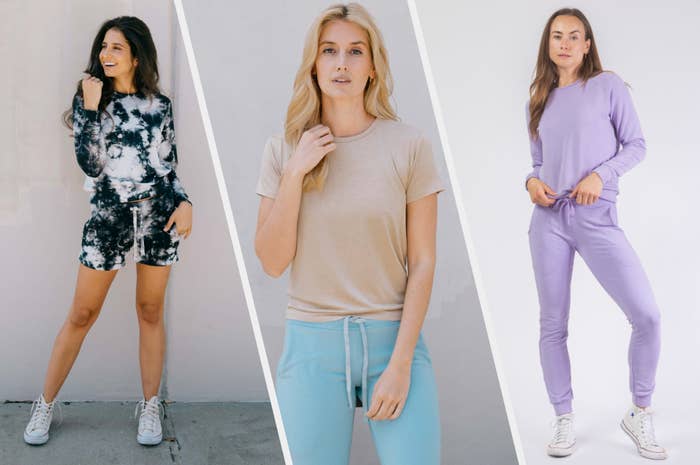Branded Clothing for Active Lifestyles: What Fabrics Support Performance?
Branded Clothing for Active Lifestyles: What Fabrics Support Performance?
Blog Article
Recognizing Clothing: The Relevance of Material Selections in Your Closet
The selection of material in apparel plays a pivotal duty in both appearances and functionality. Various products offer differing levels of breathability, sturdiness, and comfort, directly influencing the user's experience. Recognizing these nuances can boost one's closet substantially. Numerous forget exactly how these selections can affect not just personal style, however additionally sustainability. What fabric choices could redefine your closet and align it with both design and responsibility?
The Duty of Material in Style and Capability

Common Textile Types and Their Features
When picking garments, understanding the features of typical material types is essential for making notified options. Cotton, a widely-used all-natural fiber, is known for its flexibility, breathability, and soft qualities, making it ideal for casual wear and daily garments. Bed linen, another natural alternative, boasts superb moisture-wicking buildings and a distinctive texture, ideal for cozy climates.Wool, frequently favored for its warmth and resilience, differs in excellence; merino woollen is soft against the skin, while coarser types are made use of for outerwear. Synthetic fabrics like polyester and nylon supply sturdiness and resistance to wrinkles, making them popular for activewear and travel garments. Blends, which combine natural and artificial fibers, can enhance performance while preserving convenience. By identifying these textile features, individuals can pick garments that straightens with their way of living and visual choices.
Breathability and Convenience: Selecting the Right Fabrics for Different Climates
Choosing the appropriate materials for various environments can substantially enhance comfort and total wearability. Breathable materials are essential in warm climates, as they allow air circulation and wetness evaporation. Fabrics such as cotton, bed linen, and moisture-wicking synthetics effectively draw sweat away from the body, maintaining the wearer cool and dry. Alternatively, in colder environments, thicker textiles like wool or fleece offer insulation while keeping breathability, guaranteeing heat without overheating.Additionally, the option of fabric weight plays an important function; lightweight materials are more effective for summertime, whereas much heavier choices are suited for winter months wear. Recognizing the special residential properties of each fabric allows people to dress appropriately for differing climate condition. Inevitably, choosing breathable and comfortable fabrics tailored to details climates can significantly improve everyday comfort and boost the total experience of putting on clothing.
Longevity and Care: Exactly How Material Affects Longevity of Your Closet
Selecting the best materials can greatly influence the durability and care requirements of a closet. Fabrics such as cotton and polyester are understood for their strength and ease of upkeep, making them excellent for daily wear. On the other hand, fragile materials like silk and lace call for even more careful handling and specialized cleaning techniques, which can raise the moment and effort required for care. Branded Clothing.Durability is also influenced by the fabric's weave and coating; snugly woven textiles tend to withstand deterioration far better than freely woven options. Furthermore, artificial blends often provide improved resilience, integrating the very best top qualities of several fibers.Understanding the treatment instructions for each material is vital, as incorrect washing or drying can bring about early wear. Inevitably, selecting long lasting materials can lead to a longer-lasting wardrobe, decreasing the frequency of replacements and adding to an extra sustainable fashion selection
The Impact of Material on Fit and Silhouette

Sustainable Material Selections: Making Eco-Friendly Choices
The influence of fabric extends past fit and silhouette to include environmental variables, prompting a growing passion in lasting material options. Green textiles, such as organic cotton, hemp, and Tencel, are getting grip among consumers that prioritize sustainability in their closets. These materials are frequently created with fewer chemicals and water, reducing their environmental footprint.Additionally, recycled materials, made from post-consumer waste, offer an ingenious solution to the textile sector's pollution issue. Brands progressively welcome openness in their sourcing techniques, permitting customers to make enlightened choices concerning their purchases.Choosing sustainable materials not just sustains ethical techniques but likewise encourages the apparel industry to embrace even more liable production methods. As awareness of environmental concerns climbs, people are urged to assess the lasting impact of their material options, cultivating a motion towards an extra lasting and eco mindful approach to style.
Elevating Style: Just How Material Can Change an Outfit
While lots of might concentrate on color and cut when selecting an outfit, the option of fabric plays a vital role in raising design and improving overall appearance. Different materials share distinct moods and messages; for instance, silk emanates deluxe and sophistication, while denim offers a laid-back, unwinded vibe. The structure and drape of a material can drastically modify the silhouette, with structured fabrics giving a sleek appearance and softer ones producing an extra fluid, unwinded aesthetic.Moreover, the weight of the fabric affects wearability throughout seasons. Light-weight materials like linen and cotton are ideal for summertime, while much heavier materials such as woollen and velvet offer heat and style in colder months. Recognizing textile residential or check my source commercial properties, such as breathability and stretch, also empowers people to make enlightened choices that boost comfort without compromising design. Eventually, the best fabric can transform an attire from normal to extraordinary, making it a crucial factor to consider in any closet.
Regularly Asked Questions
Just how Do I Determine the Fabric Content of My Clothes?
To determine material material, one can analyze treatment tags, conduct burn examinations for fiber identification, or consult fabric examples. These methods help separate products, making sure notified selections for clothing care and upkeep in daily wear.
Can Material Option Affect My State Of Mind or Self-confidence?
Material choice can significantly impact an individual's state of mind and confidence. Branded Clothing. Certain materials might evoke sensations of comfort or beauty, while others can feel limiting or uncomplimentary, eventually affecting self-perception and psychological well-being throughout the day
What Fabrics Are Best for Delicate Skin?
For people with sensitive skin, natural fabrics like bamboo, cotton, and linen are frequently suggested. These products are breathable, hypoallergenic, and less likely to cause irritation, making them appropriate choices for convenience and skin health and wellness.
Just how Do I Correctly Wash and Take Care Of Various Fabrics?
To appropriately clean and care for different textiles, one have to take into consideration each product's certain demands, including temperature level settings, detergents, and drying out methods, guaranteeing longevity and maintaining the fabric's initial top qualities for ideal use.
Exist Details Fabrics for Athletic or Performance Put On?
Sports or efficiency wear typically utilizes materials such as polyester, spandex, and nylon. These products are designed for moisture-wicking, breathability, and flexibility, improving motion and convenience throughout physical activities while giving longevity and support. Alternatively, in chillier climates, thicker textiles like wool or fleece supply insulation while retaining breathability, ensuring warmth without overheating.Additionally, the basics option of textile weight plays a vital function; light-weight fabrics are better for summer, whereas heavier alternatives are matched for wintertime wear. In contrast, fragile materials like silk and shoelace need even more careful handling and specialized cleaning techniques, which can increase the time and initiative needed for care.Durability is additionally influenced by the textile's weave and coating; firmly woven textiles often tend to withstand wear and tear much better than loosely woven alternatives. In comparison, stiff textiles can restrict motion yet give a timeless, polished look.Moreover, the thickness and texture of the textile can affect the aesthetic perception of body form. The impact of fabric prolongs past fit and silhouette to include ecological factors, motivating a growing interest in sustainable fabric selections. The structure and drape of a fabric can significantly alter the shape, with organized materials offering a polished look and softer ones developing a more fluid, unwinded aesthetic.Moreover, the weight of the textile influences wearability throughout periods.
Report this page